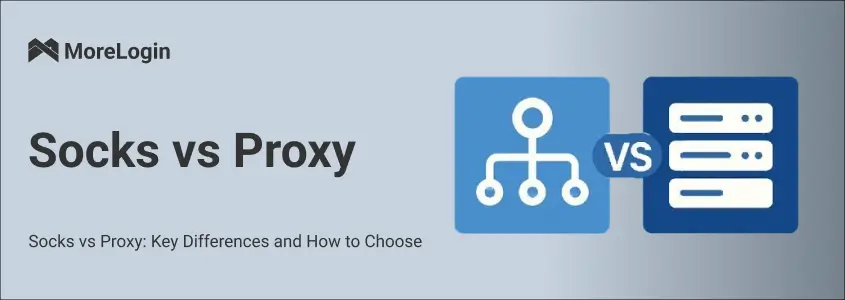
- Product

- Pricing
- Affiliate Program
- Use Cases
- Resource


Learning about SOCKS and proxy technologies helps you operate more efficiently online. Both proxy services route traffic through remote servers to hide your location. This hides your real location, but they serve different purposes.
In short, SOCKS proxies handle all network tasks without checking data, while HTTP proxies focus on browser activities. Your choice affects speed, privacy, and performance. Next, we'll explain how each tool works, help you choose the best one for your needs, and recommend reliable proxy services that keep your data secure.
Knowing how SOCKS and proxy technologies work helps you use the internet more effectively. This specialized protocol handles bandwidth-intensive operations like media streaming and P2P file sharing by establishing TCP connections. These connections ensure reliable data transmission through packet sequencing and error-correction mechanisms. When traffic routes through a SOCKS proxy server, it masks your original IP address while bypassing firewall restrictions and geo-blocks.
Unlike application-level proxies, SOCKS doesn't inspect or modify data payloads. Its core functionality focuses on creating unfiltered tunnels through network barriers. This protocol-agnostic approach supports any network traffic, including TCP/UDP, FTP, and SMTP communications across all port configurations. The current SOCKS5 standard adds UDP support.
It also includes authentication protocols. This makes it very useful for applications that are sensitive to delays. Online gaming is one example. In these cases, fast data transfer is more important than checking the content of the data.
Unlike versatile socks and proxy setups, HTTP proxies specialize exclusively in web traffic at Layer 7. They modify headers and cache content but cannot process non-HTTP protocols. This makes socks and proxy choices involving HTTP unsuitable for UDP-based applications.
These HTTP proxies serve as intermediary gateways that intercept HTTP/HTTPS requests between clients and servers. They perform critical functions like header modification (e.g., inserting X-Forwarded-For fields), content caching for static resources, and URL-based access control.
The protocol's stateless nature requires new connections for each request, simplifying the architecture but limiting efficiency. Modern implementations incorporate HTTPS encryption to establish secure tunnels, though this necessitates SSL/TLS decryption for content inspection, introducing potential man-in-the-middle vulnerabilities.
Crucially, HTTP proxies cannot process non-web protocols like FTP or UDP-based services. Organizations deploy them primarily for bandwidth optimization and compliance enforcement, such as blocking social media domains by analyzing HTTP host headers while leaving non-web applications unaffected.
Core Distinctions Explained:
1. Specialization vs Flexibility: HTTP proxies focus only on web traffic. SOCKS proxies handle any connection type.
2 . Data Handling: HTTP proxies read and modify content. SOCKS proxies simply move raw data.
3. UDP Support: SOCKS5 proxies uniquely work with UDP. This matters for games and live streams.
Picking the right SOCKS or proxy type depends on what you need:
Here's the translation following all specified requirements:
Selection Tips:
Choosing reliable proxy services requires careful evaluation. First, always avoid free socks and proxy offerings. These services typically compromise speed and expose users to security risks like data leaks or malware. Instead, prioritize providers with verified infrastructure. Look for essential features, including password authentication, IP rotation systems, and residential IP pools that mimic real user behavior. For advanced management, use MoreLogin to configure socks and proxy setups per task
This solution revolutionizes proxy workflows through three key capabilities:
Centralized Proxy Control
Manage all socks and proxy configurations (SOCKS5/HTTP/HTTPS) in one dashboard.
Assign unique proxies per browser profile with automatic rotation
Enhanced Security Integration
Combine SOCKS5 proxies with device fingerprint spoofing
Prevent platform detection through canvas/WebGL manipulation
Workflow Automation
Deploy pre-configured proxy templates for tasks like:
• E-commerce multi-accounting
• Social media growth campaigns
• Ad verification across locations
Integrate seamlessly with proxies like AstroProxy via API
The difference between HTTP and SOCKS proxy determines their use cases. SOCKS5 proxies work best for games, torrents, and non-web apps. They support all traffic types. HTTP proxies excel at web tasks like browsing and scraping. They offer caching and filtering.
Match the tool to your purpose. Need broad compatibility? Choose SOCKS5. Focused on web efficiency? Pick HTTP/HTTPS. For advanced privacy, combine SOCKS5 with tools like MoreLogin. This setup hides your digital fingerprint.